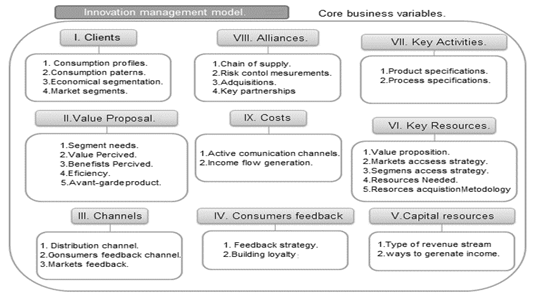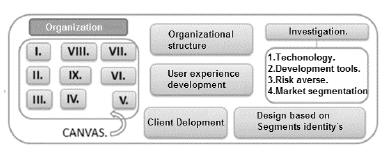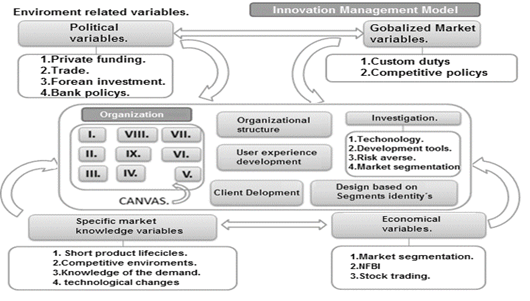1. Introduction
The research and development of innovation management tools has been a subject of multiple studies given its abilities to transform the way an organization works, granting the possibility to greater asses its target markets or even create new ones.
Given the fact that an innovation management tool has to be bounded to the context in which is going to be used in order to establish the main variables that ruled the management model and aid the decision making criteria, de present model is conceived to be applied under developing economies such as presented in Latin America.
The variables used to construct the model that aims to predict favorable conditions of developing economies in order to innovate where taken from academicals studies such as [3], [9] as well as industrial studies such as [4], among all the variables that where found those that were elected where based on the promotion of competitive environments.
In order to establish such model, a research was taken in order to identify the main context variables that settle economic growth conditions given the premise that under developed economies work as a valuable part of a global scale economy, therefore the variables needed where those that set a competitive advantage to developing countries.
The next step consisted on identifying the innovation variables, such research was based on tow premises, how innovation affect both service economies and product developing business and how innovation can be a mean of disruption on trade tendencies.
Once those variables where established a research on management models was realized based on the work done by [1,8], such research was crucial to establish an overall configuration of the previous researched variables creating a structured way to interweave the previously researched variables.
2. Variables related to a global context
In order to choose a developing economy as the environment in which innovation has to be settle as a competitive tool and a disruptive mechanism it is fundamental to identify the principal economic sectors in which the country has greater competitive advantages. It is possible to enhance the overall economy as the local industry gets supported and new business ventures are created.
In order to create a competitive environment to the already identified business sectors thus enhancing the overall economy it is fundamental to stablish whether it exist and on what proportion the local social, political and economic variables that are stated below.
• Private funding of the public productive industries.
As stated by [3,4,9], allowing private funding of the public productive ventures aims to fasten the economy allowing to create a more competitive environment as well as developing a faster and flexible innovative processes, it is possible to gain such improvements given the fact that private organizations can assess to capital flows by either bank or Non-Bank Financial Institutions (NBFI).
On the other hand the work of [6] reflects a positive correlation between public funding and an overall improvement of the innovation on a business sector.
Given that the present model is built on a holistic perspective, it is necessary to analyze the National and regional policy’s in order to stablish whether or not an organizations has economic benefits thus having to asses to public funding or else having to acquire private capital.
• Trade.
Trade as a variable is measured as the sum of the capital flows generated from import and export goods, it is often found on national reports as part of the gross domestic product (GDP).
• Foreign direct investment (FDI).
FDI is correlated to the social and political stability of a nation, a high foreign investment is often associated with a manageable industrial risk most likely produced by a healthy and productive industrial environment.
Foreign capital flows often aids local innovations given the fact that most capital flows are used in order to produce tools that enhance industrial competitively largely done by innovation measures.
• Customs duties.
As stated on the [4] publication, the variable related to customs duties measures how a country allows the sales of foreign product on its own market therefore promoting a competitive environment that is meant to empower innovation process.
Market analysis provides a set of complementary variables that will take part on the innovation management model developed to enhance developing economies.
• International trade on Stock Market.
The rate of organizations that take part on the international stock market over the total of industries on the specific nation, the index allows to estimate the capability of the existent business groups with enough capital to start new ventures related to their cluster.
• National policy’s that render economic competitiveness.
Formally expressed as “Capital Account Restrictions” on the document published by [4].
On financial perspectives, the variables that are fitted toward the model are stated below.
• Tax laws.
Allowing to adjust the interest rates often promotes the creation of new ventures as well as the amount of money lend to re-invest on corporations, such environment promotes the innovation.
• Non-Bank Financial Institutions (NBFI).
Non-bank financial institutions also known as NBFI allow to stablish certain line of credits specially thought to aid medium and small ventures.
NBFI aids the industrial development in developing economies dew that the credit lines that they offer often become attractive to small companies based on the achievable pre requisites.
• Infrastructure.
As a variable the amount of money invested in the development of infrastructure often show how a government intends on moving its local economy and develop competitive advantages.
3. Innovation related variables
In relation with the variables that best describe the process of innovation given the constrains of operating in a developing economy, [2] y [7] highlight a couple related to the process of exploration and exploitation of innovation.
Short product life cycles.
Highly competitive environments.
Short product life cycles become relatively important variable dew that it allows to create the need of constantly changing the product in order to create a more dynamic user experience.
In order to analyses whether or not an economy is taken place on a highly competitive environment is necessary to view a set of variables such as:
Knowledge of the supply and demand.
This variable allows to calculate the necessary productive capability in order meet the segment requirement it also allows to forecast the economic expansion of the market in order to foretell the future increase on sales.
Constant technological changes.
Developing economies are often characterized by the vast amount of either medium or small enterprises that contribute to the GDP (gross domestic product), an easy access to new technologies allows to achieve greater added value to the products and more operative efficiency.
Market segments.
The presence of well stablished market segments allows to target specific needs, the gathering of such information provides a valuable information on the process of development of innovative ideas.
In order to fully construct the innovation management model a set of variables where taken from the work done by [2,5,7,11].
Organizational structure.
This variable gets affected by the company’s policies crating and environment that will allow or constrain the flow of resources in order to generate new ideas that becomes innovations.
Investigation.
In order to easily estimate the variable it is necessary to analyses its components such as:
Types of market segments.
Financial risk dew to the commercial activity.
Available Technological tools
[10] Stablish some variables that properly complement the previous set of variables such as:
Client based product classification.
Such variable implies a previous segmentation of the market and establishing communication channels, both sub-variables of interest treated on the model in order to settle a proper contact between the brand and the costumer.
Product as a life style.
A variable that aims to target the innovation management model on its client communication segment, it implies how well a specific bran can stablish a products image and how well the client relates the image to a specific daily activity, thus reflecting a well-known added value.
Development of a user’s experience.
A variable that describes the how friendly or natural feels the experience of using the product, it also indicates how identified a user can get to a product.
In order to stablish some variables that aim to constant feed bach the model to adjust it to the market needs the next are proposed.
Active communication with the clients.
Improvement strategies.
4. Proposed model
Once the context and innovation related variables that rule the dynamics of innovating under developing economies have been selected, the main structure, the model that correlates the variables has to be chosen.
The main bases of the structure proposed were taken from the model proposed by [8] a management model based nine segments which held their own variables, such structure remained barely intact as a core structure that has to be feed by the context variables and also modified by the core innovation variables.
In order to understand the innovation management model that is proposed for organizations that held their economic affairs on developing economies, the core of the model is going to be shown on an schematic containing each of the nine segments and the main variables that best describe how the market is responding to the product that is been delivered.
The model requires constant managing in order to control the outcome of the innovation process, such control is possible by assessing to the information that each variable requires, dew that all of the core segments describe how the organization operates, it is possible to easily asses the data in order to constantly regulate the model.
A remarkable aspect of the core management model remains on the adaptability provided by the constant changes that the directive board of an organization makes on the corporative policies to adapt to a specific need.
A set of variables remain unattached to the core of the innovation management model, such variables are bonded to the core management model because they can be either modified or specified by the organization.
Most of the variables described on the inner model requires to stablish a strong relationship with the costumers in order to get the proper feedback to accurately valuate the variables that ruled the decision making tool, that’s the main reason that has empowered most organizations to develop user experience dynamics, customer relationship management (CRM), design based on specific market segment identity’s.
Investigation is also an important part of the core model, is a variable that depends on the organizations policies, its aim is to develop new tools as well as technologies that allows the product to evolves.
The next schematic shows the core of the innovation management model starting with the vision proposed by [8] constrained by the variables described above.
Some variables remain unattached to the innovation management model; such variables are bounded to the global context taken into account political an economical dynamics that affect the market thus affecting how an organization has to re-arrange its value proposal.
Political and economic variables often stablish how easily innovations processes can be done meanwhile social variables describe how a culture modifies consumption patterns, how short a product lifecycle can get, how open are to receive new technologies and how competitive and environment can get.
At these point it is necessary to acknowledge that the information needed to fully constrain the variables related to the context exceeds the control of the organization, therefore it becomes imperative the use of information gathering tools.
The next schematic shows the graphical description of the innovation management model including both core variables and context variables.
5. Conclusions
The fact that the innovation management model produced in this investigation has a core based on a canvas business model guaranties a holistic analysis which often aids to stablish non expected innovation possibilities, with the use of traditional administration fundaments, such innovations where often neglected given the thought organizational structures used in order to guide the organization.
The use of a canvas business structure in an innovation management model requires the use of complementary variables bounded to both the core of the model and to the outer part of it, such considerations are needed in order to stablish a model that best describe how an organization can be affected by multiple dimensions of a constantly changing environment.
The investigation showed that the context variables that are held in control by the environment and are located into the core of the innovation management model exist as a primary feedback mechanism in order to stablish an early review and properly readjust the organizations policy’s, often translated in a mayor adjustment of operation process, such changes pursue disruptive innovations in order to adapt the product to a new consumption pattern in order to achieve company’s sustainability.

















